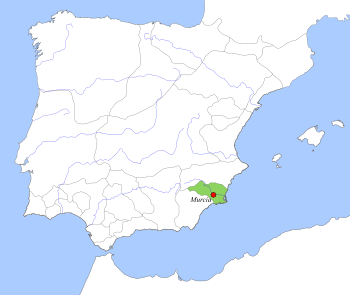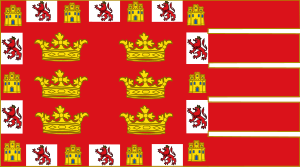Taifa of Murcia facts for kids
Quick facts for kids
Taifa of Murcia
|
|||||||||||
|---|---|---|---|---|---|---|---|---|---|---|---|
| 1011–1266 | |||||||||||

Taifa Kingdom of Murcia, c. 1037.
|
|||||||||||
| Capital | Murcia | ||||||||||
| Common languages | Arabic, Mozarabic, Ladino, Berber | ||||||||||
| Religion | Islam, Christianity (Roman Catholic), Judaism | ||||||||||
| Government | Monarchy | ||||||||||
| Historical era | Middle Ages | ||||||||||
|
• Downfall of Caliphate of Córdoba
|
1011 | ||||||||||
| 1014–1038 / 1038–1065 | |||||||||||
|
• To Seville/Almoravids
|
1078–1091 / 1091–1145 | ||||||||||
|
• To Valencia
|
1145–1147 | ||||||||||
|
• To the Almohads
|
1172–1228 | ||||||||||
| 1266 | |||||||||||
| Currency | Dirham and Dinar | ||||||||||
|
|||||||||||
The Taifa of Murcia (Arabic: طائفة مرسية) was a small Muslim kingdom in what is now southern Spain. It became independent around the 11th century. This happened after the big Caliphate of Córdoba (a powerful Muslim state) broke apart. The Taifa of Murcia was centered around the city of Murcia. It also included areas like Albacete and parts of Almería.
A "taifa" was an independent Muslim state. These states appeared in medieval Al-Andalus (Muslim Spain). The Taifa of Murcia existed at different times. It was independent for five separate periods. These periods stretched from 1011 to 1266. Finally, the kingdom of Castile took over Murcia. It then became the Kingdom of Murcia, part of the Crown of Castile.
Contents
How Murcia Began
Early History of the Region
In the year 713, Muslim armies arrived in the area. This was just two years after they invaded the Iberian Peninsula. The emir Abd al Aziz took control of the province.
Founding the City of Murcia
The city of Murcia was founded in 825 AD. It was named Medinat Mursiya. Abd ar-Rahman II, an emir (ruler) of Al-Andalus, founded it. The Muslim people, also called Moors, used the Segura River. They built a clever system of irrigation channels. This helped the town grow and become rich. This system is still used today.
A traveler named Muhammad al-Idrisi described Murcia in the 12th century. He said it was a busy city with strong defenses.
Murcia Becomes a Kingdom
After the Caliphate of Cordoba
The powerful Caliphate of Cordoba fell apart in 1031. After this, Murcia was ruled by different taifas. It was controlled by Almería, then Toledo, and later Seville. From 1078 to 1091, Abbad II al-Mu'tadid from the Taifa of Seville took control.
Battles and New Rulers
In 1165, a leader named Ibn Mardanish lost a big battle. He was defeated by the Almohads in the Battle of Fahs al-Jullab. The Almohads were another powerful Muslim group. In 1172, the Almohads took over Murcia.
From 1223 to 1243, Murcia became an independent kingdom again. It served as its own capital during this time.
Murcia and the Christian Kingdoms
Changes in Control
The Christian kingdoms to the north were growing stronger. They wanted to take back land from the Muslim rulers. This period is known as the Reconquista.
The Crown of Aragon and Castile
James II of Aragon, also known as Jaume II the Just, was a king from the Crown of Aragon. In 1296, he pushed his army south. He aimed for the rich farmlands around Murcia. At this time, Muslim rulers in Murcia had agreements with the kingdom of Castile. They ruled on behalf of Castile.
Castilian troops often raided the area. This was to show their power. But control of the border areas was always changing. There were many small fights and shifting alliances.
Finally, King Alfonso X of Castile from the Crown of Castile took the Kingdom of Murcia. Many people from northern Catalonia and Provence moved to the city. You can still find Catalan names there today. In 1296, Murcia was given to the Crown of Aragon. But in 1304, a treaty called the Treaty of Torrellas changed things. Murcia officially became part of the Crown of Castile.
See also
 In Spanish: Taifa de Murcia para niños
In Spanish: Taifa de Murcia para niños
- List of Sunni Muslim dynasties
- Almohads


